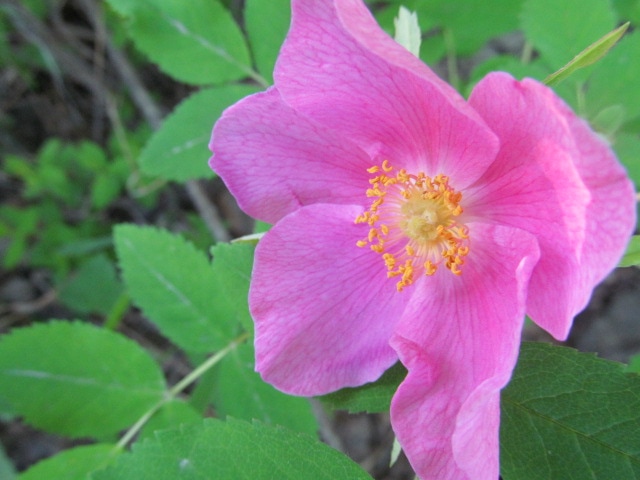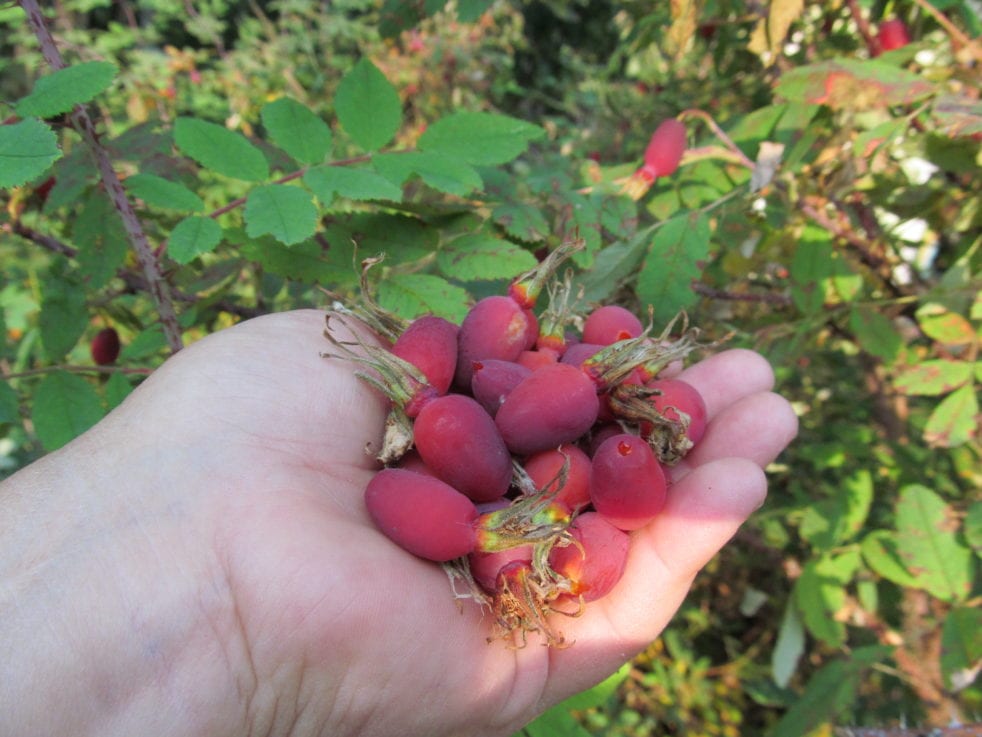
Taste the Fall season with a cup of hot and healthy rose hip tea. Harvesting and brewing your own homemade tea has never been easier or more enjoyable. I’ve often wondered why so many people (including myself) who grow roses never take advantage of this? Rose hips are also used in jelly and quick breads. But in this article, we’ll focus on my favorite–making tea!
How to identify rose hips

Maybe you just never considered the rose hip before. The “hips” are the seed pods or ‘berry’ produced by the rose. Their color ranges from an orange-red in summer to deep burgundy in Fall.
Rose hips are an anti-oxidant, with high levels of vitamin C (an immune booster). If you leave some of your rose flower heads un-pruned, they will produce tender hips that turn sweeter in the cool Fall weather. If you prefer, you can harvest wild roses which are present in almost every state across the U.S.
NOTE: All portions of the rose are edible: the petals, the seeds and the leaves. It’s not recommended to harvest hips if you spray your roses with chemicals or insecticides. If you’re not sure if a rose bush has been treated, its best to pick the hips elsewhere.
Harvesting for rose hip tea
The best time for picking rose hips is in the Fall when night time temperatures are cool. The hips are softened, but not mushy. Hips harvested after a light frost tend to be a little sweeter. Eaten raw, you won’t necessarily notice that sweetness…not like strawberries or blueberries. I find them rather bland and pasty. But those sugars will be released in the brewing process!

It’s important to use fresh picked hips as soon as possible. If you can’t use them right away, you can wash and freeze them in a plastic freezer baggie. Or dry and store in an air-tight container such as a canning jar.
A Recipe for Fresh, Rose Hip Tea

HOW MANY: You’ll need 1/4 cup of hips per one cup/serving of tea. (In Alaska, our wild rose hips are smaller than domestic varieties, so for me, that was about 17 rose hips.)
RINSE: Gently rinse the rose hips. Toss out any that may have mold, or signs of insect damage.
PREP: Cut off the top and just a bit off the bottom. If your rose hips are tender, the top should easily pull right off; you won’t need a knife.

Don’t worry about the seeds
Don’t worry about removing the seeds when brewing tea. It’s tedious and un-necessary as you’ll be straining the hips and seeds after the steeping process anyway.

Use 1 Cup of water per serving of tea
- Bring water to rapid boil. Reduce heat and add mashed hips. I read somewhere that it’s recommended to use glass, ceramic or stainless cookware, as opposed to aluminum due to the acidity in the hips.
- Steep 10-15 minutes with covered lid
- Use fine mesh sieve to strain rose hips from water
- Serve in your favorite tea cup. Add a little honey to taste
- hips can be used fresh or dried. To dry hips place them on baking sheet and put in sunny location (several hours to a few days depending on temp and humidity) OR place in oven at 110 degrees F until crispy OR use a dehydrator.
- add a little honey to taste
The appearance and consistency is a little bit like thin tomato soup. I was surprised that the tea was sweet enough so that no honey was needed! (but you decide based on your palate)
Note: rose hips can also be dried. To dry hips, place them on baking sheet and put in sunny location (several hours to a few days depending on temp and humidity) OR place in oven at 110 degrees F until crispy OR use a dehydrator. Store in an air tight container.
*Note: vitamin C levels are reduced when boiling for tea.

Author’s Photography:
See beautiful, seldom captured images of Alaska’s roses & other wildflowers HERE
You may also enjoy this Fall Season photo essay of Alaska’s plants and berries
Final Thoughts
I love the sights and smells of the Fall season. Picking berries is something I always look forward to. If you make your own home made tea, I’d love to hear your thoughts! Was this article helpful? Enjoyable? Were the directions easy to follow? Let me know in the comments below. Be sure to invite a friend over for tea!
The form you have selected does not exist.


Thanks for the tea recipe! I may try that this year. I have harvested dandelion roots in the spring for tea, but prefer the store bought powder, it tastes quite a bit like coffee without the high caffeine.
You’re welcome! And yes, I am very interested in presenting teas from other plants as well…without becoming a recipe site (ha!)…but harvesting and making use of the natural plants and berries found in and around our yards and gardens is part of the Simple Life we strive for at Make it a Garden. Thanks for your comments!
I really enjoyed your guide on making rose hip tea and learned a lot! I’m curious about the nutritional aspects, especially regarding the vitamin C levels in the tea. You mentioned that boiling reduces vitamin C levels. Could you suggest the best method to prepare rose hip tea that maximizes its vitamin C content and antioxidant benefits?
The best way to maximize nutrients in any fruit or vegetable is to eat it raw, or steam it lightly. Wild rosehips…plentiful in my area… are great to eat raw! Kind of pasty, but not bad tasting when fully rip. But of course loaded with seeds that you don’t wanna consume.
It’s my understanding that heat when cooking can reduce to a degree, the vit C levels. Probably the same with those dehydrating units for drying tea and other foods. How much, I don’t know. It’s worth researching.